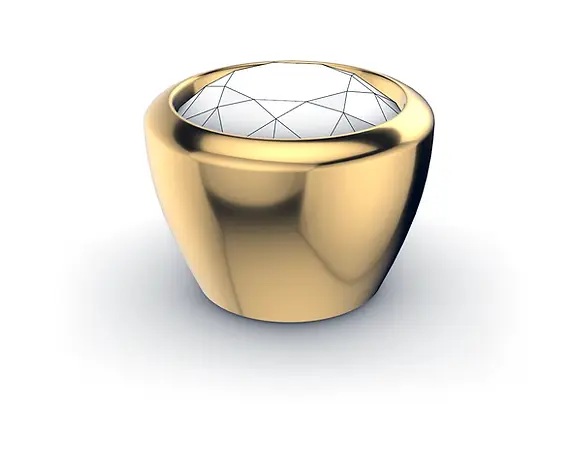
Guide di Produzione
Linee guida consigliate da seguire nei vostri progetti per soddisfare gli standard di produzione dei gioielli.
Si prega di notare che, in media, il processo di produzione può rimuovere fino a 0,2 mm di metallo.


BEZEL SETTING
The thickness of the bezel wall must be a minimum of 0.45mm.
Note that as the stone size increases, the table of the stone rises above the top surface of the bezel.
HEAD SETTING

The prong must overlap the girdle of the stone, but the seat for the stone should not cut any deeper than 25% of the prong.
The base of the prong dome should align with the table of the stone for all set types, including pinpoint setting for melee stones.
The minimum distance needed between the gallery rails/bearings is 0.4mm.
The pavilion of the gem should barely rest on the surface of the rail.

GEM POSITION
Stones must have a minimum clearance of 0.8mm from the culet to the finger rail.
SHARED PRONG
Stones set with shared prongs are suspended and secured by the prongs. Prongs must be moved into place and finished separately.
Prongs for the shared prong setting must have a minimum prong diameter of 0.45mm.
The minimum spacing in between the stones in a pinpoint setting, measured from girdle to girdle, is 0.15mm.


SURPRISE GEMS
Surprise gems bezel must be a minimum of 0.3mm above the finger rail.

RAISED LETTERS
All of the edges of the letters should have fillets and rounded corners to help with casting and to avoid investment relocation during casting.
Raised letters need a minimum metal thickness of 0.3mm.
Raised letters should not be higher than 0.6mm above the surface of the metal.
There should be a minimum spacing of 0.3mm in between the raised letters.


3D PRINT
3D printing has become popular in the world of jewelry. The technology has brought flexibility and creativity into the design, adding a plethora of possibilities and accessibility to unique jewelry pieces. The speed of 3D printing and the ability to make multiple design iterations in one day is key to using this technology. Reduced lead times make 3D printing a favorable technology to make jewelry, as this gives a competitive market edge. By opting for this production method, you can create complex one-of-a-kind designs for each customer and fabricate intricate, complex designs. Or, you can use 3D printing for prototyping to make sure the finished product is exactly what you want, even if you decide to produce multiple of the same design.
HOLLOWED OUT
Structural and external walls must have minimum metal thickness of 0.8mm.

PRODUCTION READY
The production process is somewhat complex, as 3D printing metal is one of the most complicated additive manufacturing processes. Because it’s essentially a wearable art piece, care must go into polishing after it comes off the print bed. Adding stones or jewels further complicates the process. However, this still can be the faster way of getting the perfect adornment.
(Pictures courtesy of Victor Garcia, Spain)
When it comes to 3D printing jewelry, two main methods are used: Investment casting, which doesn’t differ too much from the traditional manufacturing method, and direct 3D printing, which throws caution to the wind and paves its own way.
Investment Casting
Investment is the most popular method to 3D print jewelry. It combines 3D printing with traditional mold manufacturing techniques. The first step is to 3D print the castable model in resin. This is accomplished through either stereolithography (SLA) or digital light processing (DLP).
Next, the 3D printed model is covered in gypsum to create the mold. Once the gypsum is set, the resin is drained and liquid metal is poured in. From there, it’s a traditional metal casting process. Once the metal is set and the mold is removed, the item is carefully taken out, mechanically handled, and polished.
This method is great because you don’t need a special form of the metal and most any metal can be used.
Direct Metal 3D Printing
Direct 3D printing is exactly what it sounds like, 3D printing the final piece of jewelry directly out of metal. It’s a much less popular method as it is much more expensive than investment casting. However, it does give you a wider range of possibilities that casting isn’t capable of.
Direct 3D printing involves sintering metal powder particles together with a laser using powder bed fusion techniques, otherwise known as direct metal laser sintering (DMLS) or selective laser melting (SLM). The type of metal available depends on the 3D printer used, but there is still a wide range of metals available.